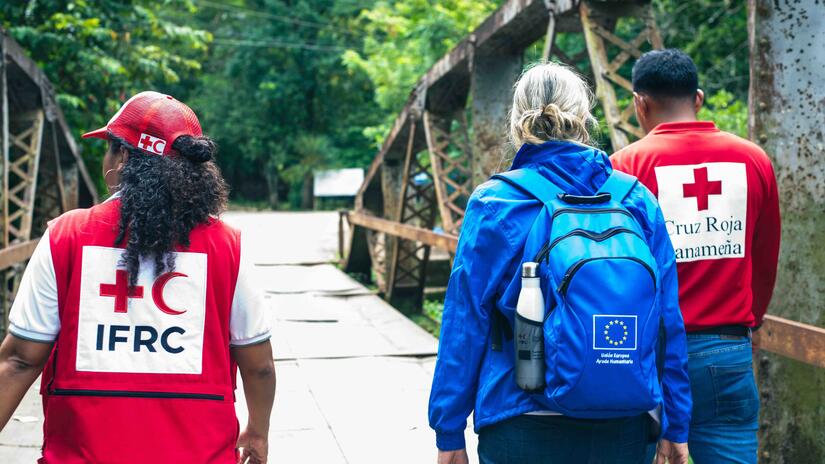A global partnership aimed at strengthening resilience and providing agency to some of the world’s most vulnerable communities will continue into its second year following a decision by Directorate-General for European Civil Protection and Humanitarian Aid Operations (DG ECHO) and the IFRC in early summer 2023.
Through the Programmatic Partnership, [ML1] European Union (EU) money will fund a range of innovative projects into 2024 that focus particularly on local action to prepare for and respond to humanitarian and health crises.
With climate change, pandemics and population movements all on the rise, these types of partnerships are crucial for enhancing locally-led anticipatory action and, where necessary, disaster response.
“The ride to localization involves having local communities in the driver’s seat from the moment of identifying needs aligned with priorities and strategies, to decision making and implementation,” said Marwan Jilani, director general of the Palestinian Red Crescent Society's (PRCS).
The partnership has reached over eight million people so far, helping communities reduce risks and react quickly to sudden-onset crises. With a EUR 70 million boost in year two, the partnership sits at over EUR 134 million and will be able to reach far more people than in the first year. All IFRC work is carried out with close cooperation with national Red Cross and Red Cresent societies, local communities and networks of volunteers.
“Humanitarian needs are growing and if we want to prepare communities to be more resilient, we need to join forces with our national societies and public institutions,” Nena Stoiljkovic, the IFRC’s Under-Secretary General for Global Relations, Humanitarian Diplomacy and Digitalization. “Only then we can be more effective and efficient. This programme is the best example we have on long-term and multi-country financing and is an inspiration for similar partnerships to come.”
The Partnership focuses of five key areas:
- Disaster preparedness and response: Preparing communities, National Societies and disaster risk management institutions to anticipate effectively, respond and recover from the impact of evolving and multiple shocks and hazards.
- Epidemic and pandemic preparedness and response: supporting communities to prevent, detect and respond to disease outbreaks.
- Supporting people on the move: providing displaced people with their basic humanitarian needs.
- Cash assistance: often the best way to help people is to give them a cash grant to invest locally, as they choose. Cash assistance gives those in need dignity and agency.
- Risk communication, community engagement and accountability: the people we support through the Programmatic Partnership are partners in our work. We listen to them carefully and act upon their opinions and needs.
A total of 12 EU Red Cross National Societies are involved in implementing the Programmatic Partnership in 24 countries around the world. Here are some examples of Partnership activities:
-
After the fires in Cox’s Bazar in Bangladesh, the world’s largest refugee camp, the Bangladesh Red Crescent and IFRC provided immediate support to families who had lost their houses and provide them with mattresses, blankets and torch lights. They also built 500 shelters in Camp 11. This funding was pooled together with the IFRC-DREF resources to provide a comprehensive response to the fire. More than €300K from the Programmatic Partnership were allocated and 2,500 people were supported through this emergency intervention.
-
The Red Cross of Chad responded immediately to the Sudan crisis, providing basic support to those people fleeing the conflict and crossing the border into Eastern Chad. The flexibility of the programme’s funding instrument enabled this timely and critical support. More than €260K were allocated and 5,883 people were reached through this action.
-
After Ecuador was struck by several simultaneous disasters — floods, landslides, building collapses, hailstorms and an earthquake – the Ecuadorian Red Cross was able to assist the affected population by providing home, tool, kitchen, hygiene and cleaning kits, as well as mosquito nets, blankets and access to safe water. More than €250k were allocated and 13,020 people were reached in this intervention.
-
Volunteers across Democratic Republic of the Congo, Honduras, Guatemala, El Salvador, and Panama have been trained to use the Nexus Environmental Assessment Tool (NEAT+), to better assess risks and post-disaster needs.
-
In Guatemala, volunteers have been trained on the use of drones for ‘photogrammetry’ – the modern way to get reliable information about physical objects and the environment through the process of recording, measuring and interpreting photographic images. The training has significantly improved the ability of volunteers to assess risk and prepare accordingly.

